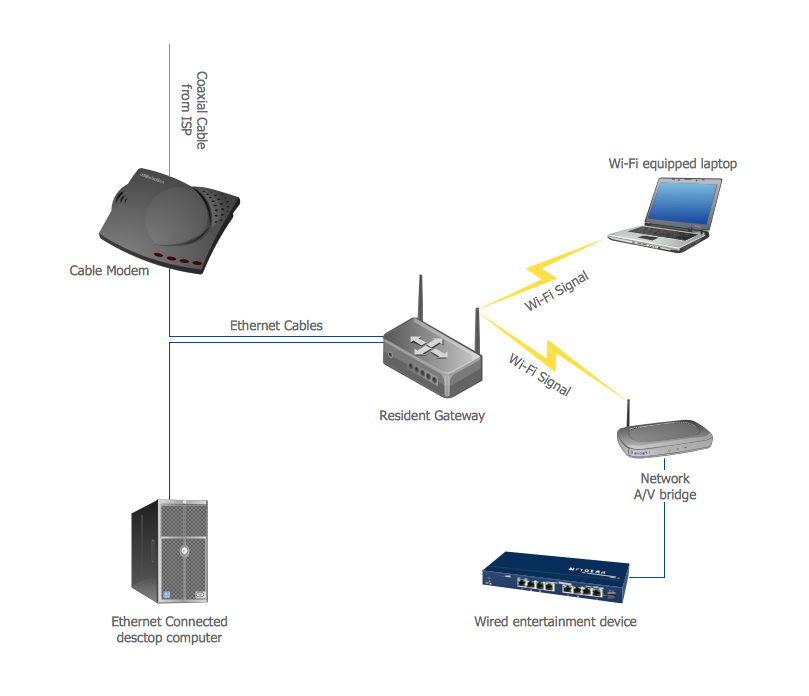Network Topologies
Network topology is a topological structure of computer network, which can be physical or logical. The physical topology depicts location of different computer network elements such as computers, cables and other devices. The logical topology visually displays network dataflows from one device to another. Sometimes network logical and physical topologies can be the same. ConceptDraw DIAGRAM diagramming and vector drawing software is powerful for drawing network maps and network topologies diagrams of any kinds and complexity thanks to the Computer Network Diagrams solution from the Computer and Networks area. ConceptDraw STORE proposes collection of network icons libraries and a lot of Network Topology Diagram examples, samples and templates which were created at ConceptDraw DIAGRAM software specially for Computer Network Diagrams solution. There are six basic types of the network topologies: Bus, Star, Ring, Mesh, Tree, Fully Connected. You can fast and easy design professional-looking diagram for each of them using the ConceptDraw DIAGRAM tools. There are plenty of web Visio-like diagramming software available. Web based diagrams software can be powerful, but sometimes it is essential to have desktop software. One of the most advanced diagrams tools like Visio for Mac OS is ConceptDraw DIAGRAM app.
Home area networks (HAN). Computer and Network Examples
A Home Area Networks (HAN) is a type of local area network that is used in an individual home. The home computers can be connected together by twisted pair or by a wireless network. HAN facilitates the communication and interoperability among digital devices at the home, allows to easier access to the entertainments and increase the productivity, organize the home security. This example was created in ConceptDraw DIAGRAM using the Computer and Networks Area of ConceptDraw Solution Park and shows the home network diagram.
Cisco Routers. Cisco icons, shapes, stencils and symbols
Network infrastructure planning is a very important process in the network construction, and the share of time allocated to this within the scope of the entire project may reach 60-80%. A competent and thorough approach to planning contributes to the quick investment return, and also increases the reliability and flexibility of the final system, reducing the probability of additional costs related to the incorrect implementation. Any planning begins with an analysis of the business requirements to the final system. Basic network parameters, which should be assessed are the scalability, accessibility, cost, speed and safety. Speed and cost are often mistaken for the most important parameters, and the rest of the parameters aren't even remembered. This is not entirely correct. Initially, it is necessary to assess the business plans for the future, because sometimes it is more profitable to invest more money in the beginning. If the business is to develop, then, consequently, demands on- Network Diagram Software Enterprise Private Network | Network ...
- Internet marketing - Concept map | Venn diagram - Internet ...
- Network Diagram Software Enterprise Private Network | Enterprise ...
- EPN Frame-Relay and Dial-up Network . Computer and Network ...
- Virtual private networks (VPN). Computer and Network Examples ...
- EPN Frame-Relay and Dial-up Network . Computer and Network ...
- Enterprise private network | Hotel Network Topology Diagram . Hotel ...
- How to Operate with Project Time Frames in ConceptDraw ...
- Wireless Networks | Network Layout Floor Plans | Hotel Network ...
- Computer and Networks Area | Network Layout Floor Plans ...
- Network diagrams with ConceptDraw PRO | Cisco Network Objects ...
- Network Diagram Software Enterprise Private Network | Virtual ...
- Block Diagram Network Topology Bus
- Network Diagramming Software for Design Cisco Network Diagrams ...
- Wired Connection Diagram
- Leaky bucket diagram | Providing telecom services - Cross ...
- Network Topologies | Fully Connected Network Topology Diagram ...
- Network diagrams with ConceptDraw PRO | Computer Network ...
- EIGRP. Computer and Network Examples | OSPF Network ...
- Network Topologies | Fully Connected Network Topology Diagram ...


